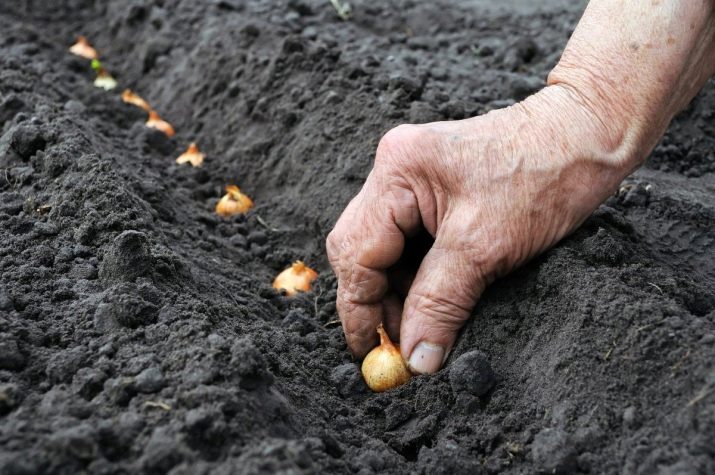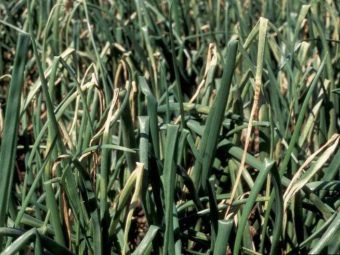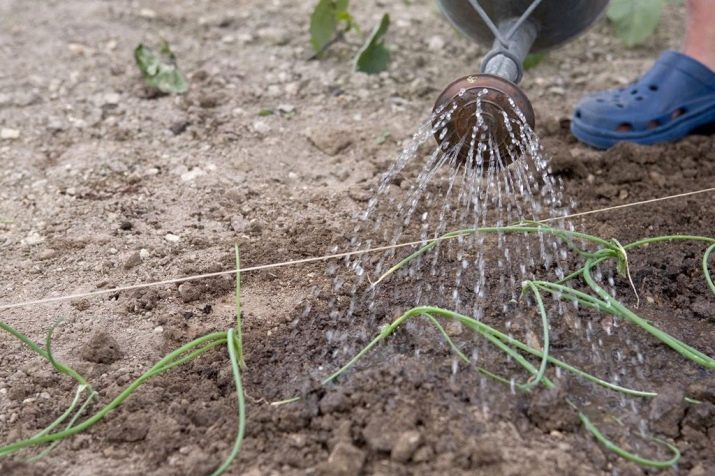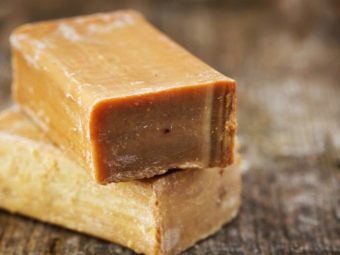How often do you need to water the onions?
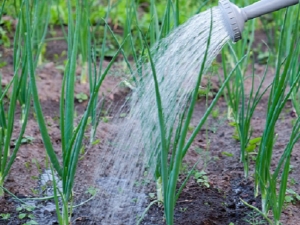
One of the most popular vegetables, no doubt, is onion.This is due to the many amazing qualities that this culture has. First of all, it is necessary to say about the extremely wide application in cooking - onions are added to a variety of dishes, and both the onions and the green part of the plants are eaten. In addition to taste, this vegetable is also valued for its healing properties, since the set of useful substances and trace elements contained in it is really impressive.
For this reason, neat beds with planted onions can be seen in almost any garden or summer cottage. This crop is suitable for cultivation in the open field or greenhouse. Many grow onions on the balcony or just on the windowsill. Despite the fact that this crop is unpretentious, and even the most experienced gardener may not grow it, it is rather difficult to get a large crop of tasty onions that will be stored for a long time. To do this, first of all, you need to understand the intricacies and peculiarities of watering this crop.
Why is it necessary to moisten the soil?
Usually, when planting any vegetable, the soil is watered. In some cases, this is done before disembarking, in others - after. Some agronomists advise planting onions immediately in moist soil, while others advise that the soil be watered after the seed is injected into it. In any case, the soil should be wet. So even the weak roots of the plant will be able to quickly assimilate all the nutrients.
Onions belong to the genus of liliaceae, since the bulb itself is the main organ. Therefore, the plant needs moisture from the beginning of its planting in the soil until the maturation of the crop. This is especially important for the development of culture. If the soil is dry, the growing season will stop. Onion heads will not be formed to the end, and the arrows will not grow. Even at the end of its “life” during a drought, onions may slow down or even stop growing.
The non-cast crop will be very small. Therefore, experienced gardeners know that if they properly water the onions, then their fertility will double. Of course, the intensity of irrigation must be calculated, given the climate in which you grow the crop. Also, do not forget that at different stages of their "life" onions require a different amount of water.
To get a healthy and rich harvest of large onions, it is not enough to moisten the soil periodically. It is necessary to know how to water the onions so that it does not turn yellow. This also applies to how often to irrigate, and whether to water the plants at the root or irrigate the greens directly. Consider answering all important questions in more detail.
Fundamental rules
In addition to compliance with the basic rules of agrotechnology, it is necessary to carry out regular watering of the beds with growing onions for eight weeks. The frequency of this procedure is primarily due to the weather, since with a large amount of precipitation it is not necessary to water the sevok. And, accordingly, on the contrary, when the weather is dry, the ground should be wetted often (at least a couple of times a week). Many gardeners are arguing about whether to water this crop during planting. There is no definite answer to this question, however, there are general recommendations that will help to achieve a bountiful harvest.
Planting material for the cultivation of this agricultural crop is sevkah, which is a small annual onion. These heads are buried in the soil by about three centimeters. The soil before this procedure is not necessary to water. Moreover, when planting seed in a dry ground, the likelihood of root damage is significantly reduced. Nevertheless, in most cases, watering after planting onions is still necessary, because it will give the planting material the necessary nutrients and trace elements.
To find out when the onions need to be watered again is quite simple - the beds should always be at least slightly damp.They should not be dried for one day.
During the period of gaining green mass and the active development of the bulbs themselves, this agricultural crop needs large volumes of liquid. Around the middle of summer, the vast majority of onion varieties cease to develop heads and begin to actively accumulate sucrose and other useful substances. Thus, at this time to water the beds with onions should be much less. If you stick to the usual irrigation schedule, then the grown onions will have an unpleasant taste, and you will not be able to keep them for a long time.
When moistening the land with growing onions in it is to be guided by a number of rules from professional farmers. First of all, never water the bow with a hose directed at the turnip. This method can greatly damage the delicate onions or even knock them out of the soil. The hose can be used only with special nozzles. Water pressure must be low.
Watering onions is best early in the morning or in the evening. It is explained simply. Even though the onion shooters have a coarse structure, the ingress of water and the intense exposure to sunlight can lead to burns.
When the bulbs reach about five centimeters in diameter, you can begin intensive root irrigation. During this period, you can water without the nozzle, but the water pressure in the hose should be reduced. Grown culture is watered by applying moisture between rows with a bow.
To get a really rich harvest of tasty, large and high-quality onions, it is recommended to install a special container on the site, which will be used to accumulate and store water. Most often, a simple metal tank or other similar object appears as a storage tank on country houses and land plots. Capacity is set at the highest point of the site. Then it is filled with water from a well, a well, or another source and left to bask in the sun for several days.
Such water is ideal for onions and any other agricultural crops. From such moisture, they will grow better, grow faster and become less susceptible to various pathogens and fungi. This is due to the fact that the temperature of water heated under the sun is approximately equal to the temperature of the environment surrounding the bulbs. Therefore, they will not experience the adverse effects of sudden temperature shocks.
Onions do not like a strong drought. However, these plants also poorly tolerate excess moisture. Under these conditions, the bulbs will start to rot very quickly. In addition, at high humidity, various diseases develop more actively, fungal diseases spread more quickly.
The most common disease that occurs during excessive watering is powdery mildew. This is a rather unpleasant disease, which entails a significant decrease in yield. Moreover, such a bow will not be able to be stored for a long time - in just a few weeks it will simply rot.
If the land plot, where it is planned to plant onion crops, is too wet, then you need to equip the beds of sufficient height. Also, excess moisture can be dealt with using a drainage system that will drain water from the site.
Process features
The process of watering the beds with onions may not seem too complicated, but it has a number of nuances that can be learned only from personal experience or from the tips of farmers. Moreover, depending on the season, method of cultivation, as well as varieties of culture, irrigation rules can vary significantly.
For example, in spring, onions planted in open ground are regularly watered with moderate amounts of water. The main thing is to find the right amount of water for irrigation in the future so that the plants do not suffer from drought or too much moisture.
At this time, they also water only between the rows of the onions, since the sprinkling method is not suitable for germinated seedlings. Water that enters the space between the arrows of the plant inevitably leads to the formation of rot.
It is important to choose the right time for watering so that it is not too hot, and the sun is not very bright, because under such conditions the moisture evaporates very quickly. In addition, in this case, you can accidentally burn the plants.
Some gardeners often plant onions before winter, that is, in the autumn months. In this case, immediately after planting, watering seedlings is not recommended, since they can germinate too quickly, which is highly undesirable when the onset of cold weather. Sprouted arrows due to frosts can suffer greatly, to the extent that the plants simply die. However, even with the threat of frost to do shelter for the beds is not too rational, because the rains at this time are not too intense. Therefore, they are unlikely to be able to sufficiently saturate the earth. For the first time, the bow, planted before winter, is watered in the spring, when the earth is free from moisture accumulated in it during the winter period.
This vegetable will grow normally and develop properly only if it receives the necessary amount of water at each stage of its development. It should take into account the dislike of onions to excess moisture. Therefore, before watering the beds once again, it is necessary not only to study the soil features on the site, but also to see the weather forecast for the next seven days. Such simple measures will be able to prevent many unpleasant consequences (ranging from the rotting of turnips and ending with the attack of various pests and diseases caused by the fungus).
To prevent the plants from attacking the onion fly, even before planting, the prepared beds can be treated with a special solution based on birch tar. To prepare this effective means of prevention, it is necessary to dilute one tablespoon of tar in ten liters of pure water. Such a treatment is able for some time to protect the onion planting from damage by a pest. If during the period of culture growth there is a large amount of precipitation, then the land is treated with a solution of birch tar again.
Consider the features of crop irrigation, depending on the stage of plant development. At the beginning of growth, as in other periods, watering onions has its own specifics. After the seedlings grow, they will need rather large volumes of moisture. The approximate amount of water that a bow requires for normal development during this period is thirty liters per square meter. If the weather is dry, the beds should be watered at intervals of five days. During the rains, watering stops. A good idea would be the installation of drip irrigation.
When ripe, young onion plants are best watered using a conventional garden watering can or a hose with a nozzle. At this time, it is important to observe the water balance and bring in so much moisture to moisten the ground to a depth of at least 10 centimeters. In the following weeks, this figure should reach twenty or even thirty centimeters. It is easy to determine if the beds need additional watering; it is enough just to dig a small hole to a depth of 10 centimeters and get a handful of soil. If it falls apart after that, then most likely it is time to water the garden.
Before harvesting the onions gradually stop watering intensively. When the leaves start to go, it means that the bulbs are completely poured and developed completely. Most often this occurs two months after transplanting.
It is impossible to water ripened onions, as it negatively affects the quality of the vegetable, therefore beds with onions are often covered with plastic wrap in case of precipitation.
What can be used besides water?
If the onions on your garden bed are already clouded, then, of course, it will grow much better. But this is not enough for a good harvest.In addition to water, you can use nutritional mixtures for watering onions. It can be both special preparations and organic. It all depends on the desired result and the possibilities of the gardener.
Salty solution
More and more summer residents today are pouring onion with salt water. Such watering will relieve plants from pests, thereby protecting the arrows from yellowing. It must be remembered that no matter what myths go about watering salt water, it will not affect the taste and speed of aging.
Sprinkle with salted onions three times. The first watering is done when the bow arrows grow five centimeters in length. The second and third watering - 10 days after the previous one. For such irrigation, you need to use only a watering can or drip technique. In no case can not just pour salt on the ground, and pour water on top of it.
To prepare a saline solution, for each watering you need to take a different amount of salt. For the first time, thirty grams of salt should be dissolved in one liter of water. For the second watering on the same amount of water you need to take forty grams. And for the third you need sixty grams of salt.
After watering with brine, it is necessary to additionally moisten the bed with warm water.
Soap solution
Water onions with soap and water only once or twice a season. Such watering is an excellent prevention of pest invasion. To prepare such a mixture, you need to take fifty grams of laundry soap. It should be crushed and dissolved in ten liters of warm water.
Ammonia
Of course, in most cases, ammonia in its pure form is not used. It is diluted with water. Ammonia has several names, so to avoid confusion, they should be remembered:
- ammonia water;
- caustic ammonium;
- ammonium hydroxide;
- ammonia hydrate.
Ammonium hydroxide is dissolved in water in such a way as to obtain a twenty-five percent solution. It can be used for watering onions. The same solution, but 10% is known as ammonia. It should not be confused with ammonia, since these are different substances.
The most common ammonium fertilizer is ammonium nitrate. It is able to increase the nitrogen content in the soil, easily absorbed by onions. A substance similar in effect is ammonia water. To prepare such a solution, you need to dilute three tablespoons of ammonia in one bucket of water.
This solution should be watered onions in the evening, directly under the root, so as not to touch the green arrows. This mixture will help significantly reduce the chance of yellowing onions. Saltwater is also a great way to deal with such a pest, like an onion fly.
As is clear from the above, there are many rules for watering onions, but they are all simple. Their observance should not cause special difficulties.
The main thing - strictly follow all the recommendations. Then everyone can grow a bountiful harvest of onions in the open field, just enough to build on the specifics of the land and climatic conditions.
How often water onions, see the next video.




